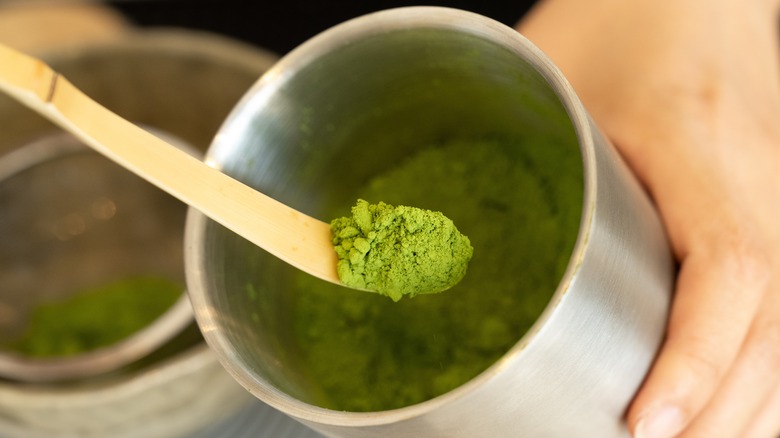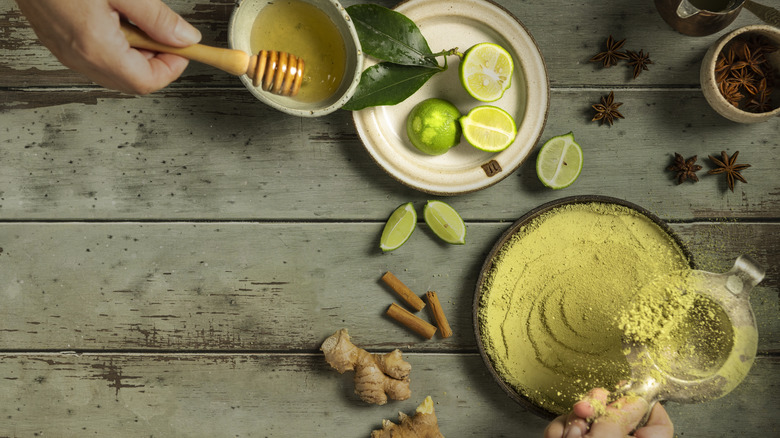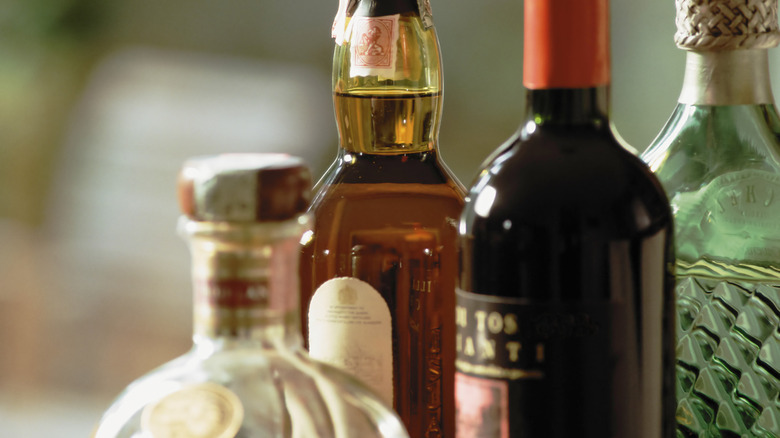8 Tips For Adding Matcha To Your Next Cocktail
Matcha is an ingredient that's beyond trending in 2024. A type of Japanese green tea that has been used in its cultural ceremonies since the 12th century, social media played a major role in driving it as a popular ingredient for America around 2015. We've moved beyond tea, with matcha now being used more frequently in cocktails, too. This can also be credited in part to the ingredient's ability to adapt and complement a wide variety of beverages recipes.
The distinctive flavor of match can be best described as toasty and earthy notes. It pairs well with many sweet and bright flavors given its deep, herbal umami profile that possesses the characteristics to blend well with many types of alcoholic spirits such as vodka and rum. Similarly, a vivid color elevates your cocktails to make them more visually alluring; and beyond its verdant hue, the fine powder form of matcha gives it the ability to blend into recipes easily. As a bonus touch point, matcha tea even offers a gentle energy boost and contains a high level of antioxidants.
With almost a decade of hospitality experience that includes working behind the bar, I can testify that matcha is something you should consider experimenting with and incorporating into your next cocktail recipe. The versatility and flavor is unmatched. But for back-up, I'm leveraging another expert to help explain the how and why of adding matcha to cocktails: Gregory Cole Johnson is the beverage manager for Patina Restaurant Group's Morimoto Asia, Enzo's Hideaway, and The Edison in Disney Springs. And these are some of his tips on how to leverage the power of matcha when building a mixed cocktail.
Know where you're sourcing you're matcha
Of matcha, Gregory Cole Johnson says, "It's amazing. Matcha has been enjoyed for centuries due to its soft, complex flavors and relaxing qualities. It adds a unique layer to cocktails that feels both refreshing and sophisticated, making it versatile for any occasion."
Matcha is generally easy to find in many shops and grocery stores given its rising popularity, and if your local bodega doesn't have it — you can always rely on Amazon and browse available options online. However, knowing where your matcha originates is very important. Japan and China are the two biggest growers and exporters of green tea powder, and they also share a disputed origin over who invented matcha powder.
The Japanese method of processing green tea into matcha — which involves stone grinding and steaming — makes it more laborious and expensive, but also of a higher quality than Chinese matcha. It's slightly sweeter and more grassy, rather than earthen or bitter. Reputable, transparent suppliers should be easy to vet in terms of your tea's specific origin, and even third party testing of the heavy metal content in the soil where it was grown.
One brand I use and recommend is Japanese Tea Kimikura, a company that's been around for almost a decade and produces a competitive and luxe ceremonial matcha. It's grown in Kyoto, a city known for profoundly traditional approaches. I'm also a fan of using the brand Encha and its organic ceremonial grade matcha for cocktails. It offers several packaging options which allow for varying price points depending on your budget. The ceremonial-grade is a first harvest matcha grown on a farm located in Uji, a small city that sits between Kyoto and Nara.
Know the quality of your matcha
There are three main grades of matcha: culinary, premium, and ceremonial. Culinary grade is a slightly lower grade of matcha than ceremonial. It has a robust, slightly mineral umami taste that makes it a more appropriate choice in your daily cooking. Premium grade is a subset of culinary grade that holds more intense grassy notes and bittersweet undertones. Due to its more pungent tasting profile and its smaller particle size, the premium category can be whisked to form a silkier, less powdery beverage which is key to making an excellent matcha latte versus leveraging it in cocktails.
The highest quality grade of matcha is unquestionably the ceremonial grade. "Ceremonial-grade matcha is key for quality in cocktails ... I find the best flavor and texture come from Japanese ceremonial matcha," says Gregory Cole Johnson. Its leaves are picked from the first harvest of the year, thus resulting in a more flavorful product that is smoother in texture, nutrient-rich, and has a soft sweetness possessing the most vivid color. It's also the best selection when adapting it to cocktails due to its fine texture allowing for it to dissolve into water more easily.
Ceremonial-grade typically costs between three-quarters to one dollar per gram, and a 30 gram tin usually costs around between 25 and 30 dollars, while culinary-grade powders are listed at a more affordable price point costing roughly between a quarter or half dollar per gram.
Avoid pre-batched or pre-flavored products
While many professional bartenders and mixologists tend to avoid pre-flavored matcha products, if you're hoping to simplify the process, then Gregory Cole Johnson recommends Monin. The "concentrate provides a usable alternative that's not overly sweet." Monin's matcha concentrate consists of basic ingredients that can allow you a balanced harmony between matcha's organic bitter taste with some subtle sweetness, but without adding much sugar or other artificial ingredients.
That said, you'll want to avoid pre-batched products if you can because the liquid will eventually oxidize, inherently changing its color, diminishing its aromatics, and eventually developing more bitter notes. That's why even Monin concentrate features ingredients like turmeric and spirulina to support color. You wouldn't serve guacamole that's been pre-made and sitting in the fridge to your guests when hosting a party would you? The same rules should apply here.
Pre-flavored matcha can also be unhealthy as most of the products on shelves typically contain added sugar and use lower-grade powder, similar to pre-batched selections. Pre-batched matcha products can also contain unreliable amounts of caffeine.
Remember a little power goes a long way
Given that matcha is made of the whole green leaf, it is potent. Just a touch of matcha goes a long way when employing it in your cocktails. Just like saffron, you don't want to overdo it by using too much of a good thing. This will result in an overpoweringly strong and bitter taste plus a very thick and sludgy texture.
If you're new to matcha, begin using your high-quality, Japanese ceremonial-grade in modest amounts then gradually increase. You'll have the ability to taste and slowly balance the taste profile to your liking; and by following these specifications, matcha's natural bitterness should fade into a more pleasant umami profile.
While there is no standard ratio of matcha powder when making cocktails, from my experience, I've determined that a quarter teaspoon to one ounce of hot water is a safe bet for most cocktails. When I've made matcha martinis, for example, I've used a maximum of a half teaspoons of matcha powder dissolved in two ounces (roughly 60 milliliters) of hot water. You may even want to start with ⅛-teaspoon until you've flesh out how much to use in your drink.
Practice your anti-clumping technique
First thing's first, once you've purchased the suggested ceremonial-grade product, you will need to add a few scoops of matcha powder into the sifter. It's best if you use a fine mesh sieve or stainless steel strainer to patiently sift the powder, pushing the matcha with a spoon into your bowl. By sifting, you remove clumps that may have formed, making the byproduct easier to dissolve and mix in water.
A safe and general rule of thumb to produce a matcha shot includes two ounces of water heated to 175 degree F for a quarter to half teaspoon of powder. Use a traditional bamboo matcha whisk. Whisk vigorously in a "W" motion until the liquid develops into a soft and frothy texture. This will help bring out the alluring nuttiness and mellow grassy aromatics. Consider using a hand frother versus a traditional whisk, the former can help dissolve any clumps.
Use your matcha immediately to capitalize on its superior qualities. While it's not recommend you prepare batches in lump sums, understandably, if you're making matcha for a number of guests you may need to save time. To store matcha, immediately pour your liquid in an airtight container (I recommend using glass versus plastic) and place in the fridge. If your cocktail recipe calls for milk and it has already been combined with matcha, you can leave it in the fridge for up to 12 hours, however if you store the matcha liquid exclusively, you can double its shelf live of up to 24 hours.
Pair it with regionally complementing flavors
Given matcha's versatility, it's no surprise that its cocktails can be enjoyed with a wide selection of different ingredients possessing various flavors. The ingredients you select will be contingent on the recipe you're trying to replicate.
If you're trying to create a refreshing cocktail, pineapple juice complements it by balancing it out with its sweet, yet tart profile. Additional fruits that produce a refreshing drink include, but are not limited to: grapefruits, oranges and, as in many other recipes, lemon and lime are also great.
However, if you'd like to imbibe with a more earthy drink at the end of the day, "Matcha's nutty and umami tones pair exceptionally with orgeat, oat milk, or coconut," says Gregory Cole Johnson. "These flavors enhance matcha's depth and create a rich, unique profile."
Perhaps your desired end result is a sweet and fruit forward beverage, use fruits like raspberries and strawberries; if you're craving a more delicate and floral profile, rose and lavender are beautiful selections that pair excellently. Ultimately, the cocktail recipe you select will dictate what ingredients you'll utilize.
Don't be afraid to experiment with different spirit pairings
You're probably curious what spirits pair best with the green powder and this is a great opportunity to embark on your own personal adventure whether that's in your kitchen or bar. Given matcha's adaptability, this ingredient allows individuals more freedom to pursue more bold undertakings, the opportunity to push boundaries and take risks.
It's worth mentioning that our expert Gregory Cole Johnson states, "Matcha pairs beautifully with softer spirits like vodka, gin, or clear rum, which allow the matcha flavor to shine." But again, "Don't be afraid to experiment — as long as it's balanced, anything is possible! I recently crafted a matcha cocktail with almond-infused grappa that a guest described as 'transcendent."
To Johnson's point, referencing my extensive background in hospitality, I've created and enjoyed recipes that used spirits that weren't as delicate as the aforementioned spirits. I've used a Japanese whiskey for a classic matcha whiskey highball when I craved a simple and slightly grassy cocktail. Remember a little powder goes a long way so if you're not happy with the end results, just try again with another spirit.
Don't fear an attempt at traditional cocktails
Given Gregory Cole Johnson's expertise, he's got several cocktails you can try at home if you're looking for some inspiration. Some of his favorite recipes include a matcha hot toddy with soju. This is a great option given we're in fall and quickly entering the winter season. If you've followed our tips up until here, using ceremonial-grade matcha, this beverage is velvety smooth, a pleasant balance of earthy and sweet flavors, fragrant and an excellent cozy choice.
Morimoto's Matcha Raku, which uses vanilla vodka, oat milk, matcha, lavender, fee foam, and lemon bitters. The fee foam is a clear, tasteless, vegan-friendly liquid that helps create a foamy head when added to cocktails for a fluffy appearance. Named after Iron Chef Masaharu Morimoto, who possesses an easy-going demeanor and the word "raku," which translates to "easy" or "comfortable," the drink is exactly how it feels to imbibe.
One more of Johnson's favorite traditional cocktail recipes, however, is a matcha Mai Tai. In it, the orgeat is cold-infused with matcha. This results in a creamy, umami-rich flavored drink with a sweet aftertaste that balances quite nicely with a classic Mai Tai's rum. Don't forget to add orgeat syrup and lime juice. With enough of these cocktails, you'll be researching your next tropical vacation or picturing yourself on some beach in Hawaii.








